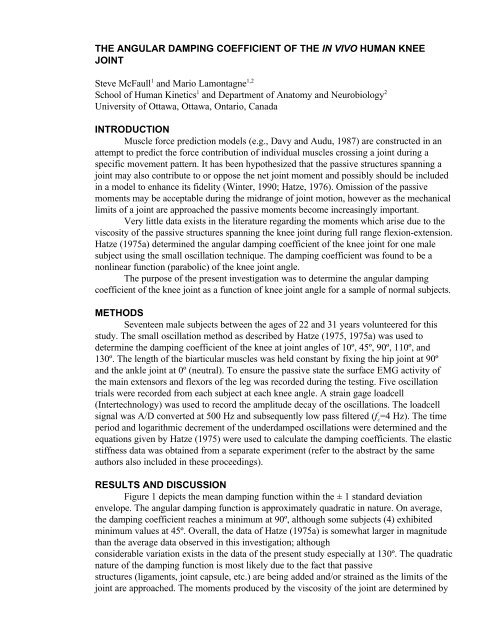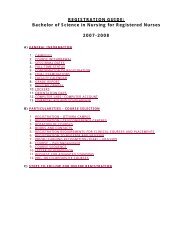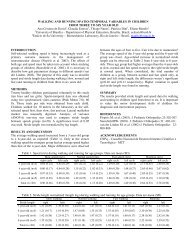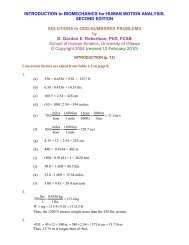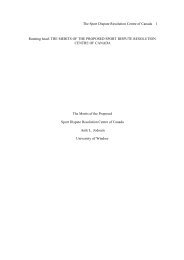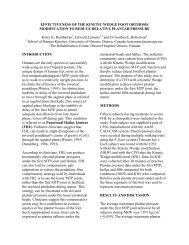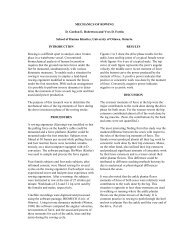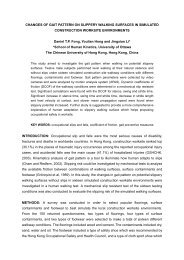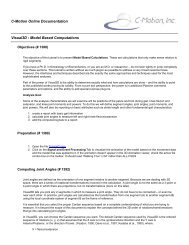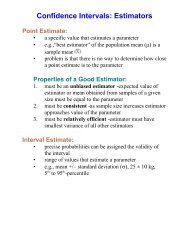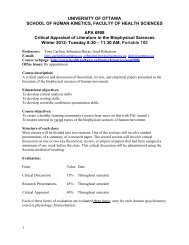Angular damping coefficient of the in vivo human knee joint.
Angular damping coefficient of the in vivo human knee joint.
Angular damping coefficient of the in vivo human knee joint.
You also want an ePaper? Increase the reach of your titles
YUMPU automatically turns print PDFs into web optimized ePapers that Google loves.
THE ANGULAR DAMPING COEFFICIENT OF THE IN VIVO HUMAN KNEE<br />
JOINT<br />
Steve McFaull 1 and Mario Lamontagne 1,2<br />
School <strong>of</strong> Human K<strong>in</strong>etics 1 and Department <strong>of</strong> Anatomy and Neurobiology 2<br />
University <strong>of</strong> Ottawa, Ottawa, Ontario, Canada<br />
INTRODUCTION<br />
Muscle force prediction models (e.g., Davy and Audu, 1987) are constructed <strong>in</strong> an<br />
attempt to predict <strong>the</strong> force contribution <strong>of</strong> <strong>in</strong>dividual muscles cross<strong>in</strong>g a jo<strong>in</strong>t dur<strong>in</strong>g a<br />
specific movement pattern. It has been hypo<strong>the</strong>sized that <strong>the</strong> passive structures spann<strong>in</strong>g a<br />
jo<strong>in</strong>t may also contribute to or oppose <strong>the</strong> net jo<strong>in</strong>t moment and possibly should be <strong>in</strong>cluded<br />
<strong>in</strong> a model to enhance its fidelity (W<strong>in</strong>ter, 1990; Hatze, 1976). Omission <strong>of</strong> <strong>the</strong> passive<br />
moments may be acceptable dur<strong>in</strong>g <strong>the</strong> midrange <strong>of</strong> jo<strong>in</strong>t motion, however as <strong>the</strong> mechanical<br />
limits <strong>of</strong> a jo<strong>in</strong>t are approached <strong>the</strong> passive moments become <strong>in</strong>creas<strong>in</strong>gly important.<br />
Very little data exists <strong>in</strong> <strong>the</strong> literature regard<strong>in</strong>g <strong>the</strong> moments which arise due to <strong>the</strong><br />
viscosity <strong>of</strong> <strong>the</strong> passive structures spann<strong>in</strong>g <strong>the</strong> <strong>knee</strong> jo<strong>in</strong>t dur<strong>in</strong>g full range flexion-extension.<br />
Hatze (1975a) determ<strong>in</strong>ed <strong>the</strong> angular <strong>damp<strong>in</strong>g</strong> <strong>coefficient</strong> <strong>of</strong> <strong>the</strong> <strong>knee</strong> jo<strong>in</strong>t for one male<br />
subject us<strong>in</strong>g <strong>the</strong> small oscillation technique. The <strong>damp<strong>in</strong>g</strong> <strong>coefficient</strong> was found to be a<br />
nonl<strong>in</strong>ear function (parabolic) <strong>of</strong> <strong>the</strong> <strong>knee</strong> jo<strong>in</strong>t angle.<br />
The purpose <strong>of</strong> <strong>the</strong> present <strong>in</strong>vestigation was to determ<strong>in</strong>e <strong>the</strong> angular <strong>damp<strong>in</strong>g</strong><br />
<strong>coefficient</strong> <strong>of</strong> <strong>the</strong> <strong>knee</strong> jo<strong>in</strong>t as a function <strong>of</strong> <strong>knee</strong> jo<strong>in</strong>t angle for a sample <strong>of</strong> normal subjects.<br />
METHODS<br />
Seventeen male subjects between <strong>the</strong> ages <strong>of</strong> 22 and 31 years volunteered for this<br />
study. The small oscillation method as described by Hatze (1975, 1975a) was used to<br />
determ<strong>in</strong>e <strong>the</strong> <strong>damp<strong>in</strong>g</strong> <strong>coefficient</strong> <strong>of</strong> <strong>the</strong> <strong>knee</strong> at jo<strong>in</strong>t angles <strong>of</strong> 10º, 45º, 90º, 110º, and<br />
130º. The length <strong>of</strong> <strong>the</strong> biarticular muscles was held constant by fix<strong>in</strong>g <strong>the</strong> hip jo<strong>in</strong>t at 90º<br />
and <strong>the</strong> ankle jo<strong>in</strong>t at 0º (neutral). To ensure <strong>the</strong> passive state <strong>the</strong> surface EMG activity <strong>of</strong><br />
<strong>the</strong> ma<strong>in</strong> extensors and flexors <strong>of</strong> <strong>the</strong> leg was recorded dur<strong>in</strong>g <strong>the</strong> test<strong>in</strong>g. Five oscillation<br />
trials were recorded from each subject at each <strong>knee</strong> angle. A stra<strong>in</strong> gage loadcell<br />
(Intertechnology) was used to record <strong>the</strong> amplitude decay <strong>of</strong> <strong>the</strong> oscillations. The loadcell<br />
signal was A/D converted at 500 Hz and subsequently low pass filtered (f c =4 Hz). The time<br />
period and logarithmic decrement <strong>of</strong> <strong>the</strong> underdamped oscillations were determ<strong>in</strong>ed and <strong>the</strong><br />
equations given by Hatze (1975) were used to calculate <strong>the</strong> <strong>damp<strong>in</strong>g</strong> <strong>coefficient</strong>s. The elastic<br />
stiffness data was obta<strong>in</strong>ed from a separate experiment (refer to <strong>the</strong> abstract by <strong>the</strong> same<br />
authors also <strong>in</strong>cluded <strong>in</strong> <strong>the</strong>se proceed<strong>in</strong>gs).<br />
RESULTS AND DISCUSSION<br />
Figure 1 depicts <strong>the</strong> mean <strong>damp<strong>in</strong>g</strong> function with<strong>in</strong> <strong>the</strong> ± 1 standard deviation<br />
envelope. The angular <strong>damp<strong>in</strong>g</strong> function is approximately quadratic <strong>in</strong> nature. On average,<br />
<strong>the</strong> <strong>damp<strong>in</strong>g</strong> <strong>coefficient</strong> reaches a m<strong>in</strong>imum at 90º, although some subjects (4) exhibited<br />
m<strong>in</strong>imum values at 45º. Overall, <strong>the</strong> data <strong>of</strong> Hatze (1975a) is somewhat larger <strong>in</strong> magnitude<br />
than <strong>the</strong> average data observed <strong>in</strong> this <strong>in</strong>vestigation; although<br />
considerable variation exists <strong>in</strong> <strong>the</strong> data <strong>of</strong> <strong>the</strong> present study especially at 130º. The quadratic<br />
nature <strong>of</strong> <strong>the</strong> <strong>damp<strong>in</strong>g</strong> function is most likely due to <strong>the</strong> fact that passive<br />
structures (ligaments, jo<strong>in</strong>t capsule, etc.) are be<strong>in</strong>g added and/or stra<strong>in</strong>ed as <strong>the</strong> limits <strong>of</strong> <strong>the</strong><br />
jo<strong>in</strong>t are approached. The moments produced by <strong>the</strong> viscosity <strong>of</strong> <strong>the</strong> jo<strong>in</strong>t are determ<strong>in</strong>ed by
multiply<strong>in</strong>g <strong>the</strong> <strong>damp<strong>in</strong>g</strong> <strong>coefficient</strong><br />
by <strong>the</strong> angular velocity <strong>of</strong> <strong>the</strong> leg<br />
(<strong>in</strong> rad/s). For example, if <strong>the</strong><br />
angular velocity is 10 rad/s <strong>the</strong><br />
passive viscous moment at 10º<br />
would be about 13 N.m. S<strong>in</strong>cel <strong>the</strong><br />
small oscillation method is a l<strong>in</strong>ear<br />
approximation, <strong>the</strong> values <strong>of</strong> <strong>the</strong><br />
<strong>damp<strong>in</strong>g</strong> <strong>coefficient</strong>s presented <strong>in</strong><br />
this study probably represent <strong>the</strong><br />
upper limits s<strong>in</strong>ce at higher<br />
velocities <strong>the</strong> viscosity <strong>of</strong> <strong>the</strong><br />
passive tissues decreases due to <strong>the</strong><br />
nonnewtonian (thixotropic)<br />
characteristics <strong>of</strong> biological tissues<br />
and fluids (Fung, 1981).<br />
In summary, <strong>the</strong> passive<br />
moments which arise due to <strong>the</strong><br />
viscosity <strong>of</strong> <strong>the</strong> <strong>knee</strong> jo<strong>in</strong>t may be<br />
significant <strong>in</strong> magnitude especially<br />
for movements <strong>in</strong> which <strong>the</strong> <strong>knee</strong><br />
jo<strong>in</strong>t approaches its limits and <strong>the</strong><br />
magnitude <strong>of</strong> <strong>the</strong> net jo<strong>in</strong>t moment<br />
is relatively small - such as dur<strong>in</strong>g<br />
<strong>the</strong> late sw<strong>in</strong>g phase <strong>of</strong> gait. If a<br />
portion <strong>of</strong> <strong>the</strong> observed net jo<strong>in</strong>t<br />
Figure 1. Mean angular <strong>damp<strong>in</strong>g</strong> <strong>coefficient</strong> <strong>of</strong><br />
<strong>the</strong> <strong>knee</strong> jo<strong>in</strong>t as a function <strong>of</strong> jo<strong>in</strong>t angle.<br />
Dotted l<strong>in</strong>es are ± 1 S.D.<br />
moment could be satisfied passively, this will have implications <strong>in</strong> <strong>the</strong> magnitudes <strong>of</strong> <strong>the</strong><br />
predicted muscle forces.<br />
REFERENCES<br />
Davy, D.T., and Audu, M.L. (1987). Journal <strong>of</strong> Biomechanics, 20(2), 187-202.<br />
Fung, Y.C. (1981). Biomechanics: Mechanical Properties <strong>of</strong> Liv<strong>in</strong>g Tissues. New York:<br />
Spr<strong>in</strong>ger-Verlag.<br />
Hatze, H. (1975). European Journal <strong>of</strong> Applied Physiology, 34, 217-226.<br />
Hatze, H. (1975a). Ph.d. Thesis. University <strong>of</strong> South Africa.<br />
Hatze, H. (1976). Ma<strong>the</strong>matical Biosciences, 28, 99-135.<br />
W<strong>in</strong>ter, D.A. (1990). Biomechanics and Motor Control <strong>of</strong> Human Movement (2 nd ed.).<br />
New York: John Wiley and Sons.<br />
ACKNOWLEDGEMENTS<br />
This study was partly funded by <strong>the</strong> Natural Sciences and Eng<strong>in</strong>eer<strong>in</strong>g Council and<br />
<strong>the</strong> Research Committee <strong>of</strong> <strong>the</strong> University <strong>of</strong> Ottawa.


